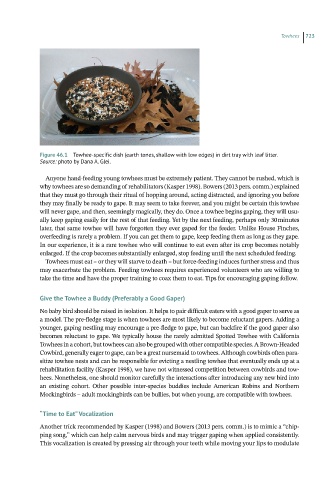Page 721 - Hand rearing birds second
P. 721
Towhees 723
Figure 46.1 Towhee-specific dish (earth tones, shallow with low edges) in dirt tray with leaf litter.
Source: photo by Dana A. Glei.
Anyone hand‐feeding young towhees must be extremely patient. They cannot be rushed, which is
why towhees are so demanding of rehabilitators (Kasper 1998). Bowers (2013 pers. comm.) explained
that they must go through their ritual of hopping around, acting distracted, and ignoring you before
they may finally be ready to gape. It may seem to take forever, and you might be certain this towhee
will never gape, and then, seemingly magically, they do. Once a towhee begins gaping, they will usu-
ally keep gaping easily for the rest of that feeding. Yet by the next feeding, perhaps only 30 minutes
later, that same towhee will have forgotten they ever gaped for the feeder. Unlike House Finches,
overfeeding is rarely a problem. If you can get them to gape, keep feeding them as long as they gape.
In our experience, it is a rare towhee who will continue to eat even after its crop becomes notably
enlarged. If the crop becomes substantially enlarged, stop feeding until the next scheduled feeding.
Towhees must eat – or they will starve to death – but force‐feeding induces further stress and thus
may exacerbate the problem. Feeding towhees requires experienced volunteers who are willing to
take the time and have the proper training to coax them to eat. Tips for encouraging gaping follow.
Give the Towhee a Buddy (Preferably a Good Gaper)
No baby bird should be raised in isolation. It helps to pair difficult eaters with a good gaper to serve as
a model. The pre‐fledge stage is when towhees are most likely to become reluctant gapers. Adding a
younger, gaping nestling may encourage a pre‐fledge to gape, but can backfire if the good gaper also
becomes reluctant to gape. We typically house the rarely admitted Spotted Towhee with California
Towhees in a cohort, but towhees can also be grouped with other compatible species. A Brown‐Headed
Cowbird, generally eager to gape, can be a great nursemaid to towhees. Although cowbirds often para-
sitize towhee nests and can be responsible for evicting a nestling towhee that eventually ends up at a
rehabilitation facility (Kasper 1998), we have not witnessed competition between cowbirds and tow-
hees. Nonetheless, one should monitor carefully the interactions after introducing any new bird into
an existing cohort. Other possible inter‐species buddies include American Robins and Northern
Mockingbirds – adult mockingbirds can be bullies, but when young, are compatible with towhees.
“Time to Eat” Vocalization
Another trick recommended by Kasper (1998) and Bowers (2013 pers. comm.) is to mimic a “chip-
ping song,” which can help calm nervous birds and may trigger gaping when applied consistently.
This vocalization is created by pressing air through your teeth while moving your lips to modulate

